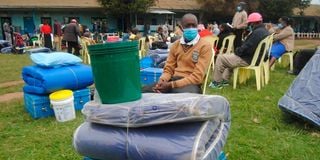Premium
Parents, learners wait for Form 1 selection results

Form One students wait to be admitted at Elburgon Secondary School in Nakuru County during the Form One admission on August 2, 2021.
Parents, teachers and the 2022 Kenya Certificate of Primary Education (KCPE) examination candidates are waiting with bated breath for the results of computerised Form One selection before the academic year begins on January 23.
Some 1,233,852 candidates sat the tests. They all qualify for admission to Form One in line with the government’s 100 per cent transition policy.
Of the total candidates, some 620,965 (50.32 per cent) were boys while 612,887 were female.
The top 10 candidates (five boys and five girls) from every sub-county will be placed in the national schools of their choice.
The country has 290 sub-counties, meaning 2,900 learners will get their preferred schools.
The government has not changed Form One placement criteria, which lay emphasis on merit, equity and choice.
“Form One selection is computerised. That is what we used,” Education Cabinet Secretary Ezekiel Machogu told the Sunday Nation.
National schools scramble
It means the scramble for slots at national schools, even after the selection, will be experienced as has been the case in the past.
Some Kenyans are concerned, saying the selection may favour public schools.
National Parents Association Chairman, Silas Obuhatsa, called for transparency and accountability in the selection.
He said past Form One selections disadvantaged children from private schools.
“We call for fairness in the selection that is solely conducted by the Ministry of Education. Children should be given a chance to join schools of their choice. Parents need to be involved in the exercise in future,” Mr Obuhatsa said.
He urged the government to ensure children from private schools are placed in “giant” national schools.
“Children are equal. Any child who scored marks to join such a school should not be denied the opportunity. Parents are also equal. There are no private or public parents,” he added.
Mr Obuhatsa urged the Ministry of Education to ensure students are not placed in schools they never selected.
“Sending children to far-flung schools they never chose also needs to end,” he said.
He gave the example of a student in Kilifi getting an admission letter from a school in Meru County, saying that would inconvenience the child and the parent.
Mr Obuhatsa added that travelling and locating the school may be a challenge.
The Form One selection, which is being conducted by the Ministry of Education, the Kenya National Examinations Council and the ICT Authority is to be concluded this weekend and results released on Monday or Tuesday.
Fair process
Like others, the Kenya Union of Post-Primary Education Teachers (Kuppet) urged the ministry to be fair.
“If a child is not selected to a school of his choice, he should be given a chance to join an institution of the same category. The criterion is according to the candidate’s choices and merit,” Kuppet Secretary-General Akelo Misori said.
He added that despite the 100 per cent transition rule, the choice of the candidate should supersede the interests of other parties.
Mr Misori lauded the computer-generated placement system, saying it has been fair.
“An example is where more than 100,000 children selected a school that can only accommodate 600. Even if they all qualify to join the school, they cannot be admitted. The computer system, however, places them where services of the same nature can be provided,” he said.
Mr Misori said learning institutions are similar but due to stability and perceived good performance, some gain popularity among children and their parents.
Mr Machogu on December 22, 2022, said Form One selection for all categories of schools would have been concluded on January 16, 2023, to give parents adequate preparation time.
The minister added that all the 2022 KCPE examination candidates would be admitted to Form One under the 100 per cent transition policy.
Form One selection is based on performance, choice and the capacity of schools.
The ministry also applies affirmative action, especially in national schools.
Selection process
A KCPE candidate selects 11 secondary schools before sitting the examination. One picks four national schools – one from each of the four clusters.
For extra-county schools, the ministry uses a 15:35:50 ratio, with the host sub-county getting 15 per cent of the places, the county getting 35 per cent while candidates from other regions get 50 per cent.
A KCPE examination candidate selects three extra-county schools.
Candidates select two county and two sub-county schools.
Special needs institutions are categorised as national, meaning they admit students from all over the country.
There are 112 national schools, 776 extra-county, 1,301 county, 6,297 sub-county and 1,301 private secondary schools in Kenya.
The country has 1,803 public boarding secondary schools and 479 private ones while there are 5,029 public and 432 private day schools.
Those that have boarding and day wings are 390 (private) and 2,245 (public).
Inmates, overage candidates and those in refugee camps are not placed in secondary schools.
Some national schools pre-select their learners.
The candidates were examined in English, mathematics, science, Kiswahili and social studies and religious education from November 28 to 30 last year.
This is the second-last KCPE examination. The last 8-4-4 cohort is to complete primary school next year, giving way to the competency-based curriculum.
Kenya Private Schools Association Coast Chapter Assistant Secretary, George Gitonga, called for fairness in the allocation of slots to secondary schools.
Mr Gitonga is the Fairfield Academy director.





